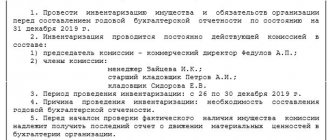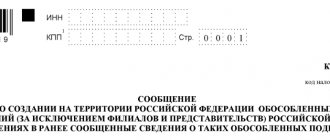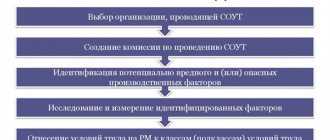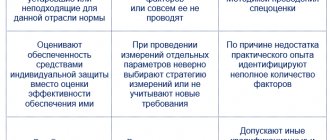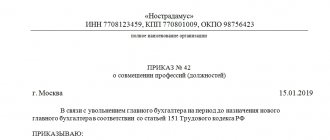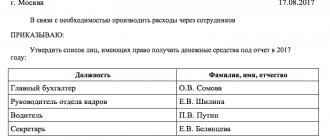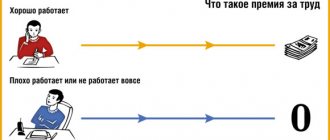The set of measures that are carried out by the employer together with experts from the organization that identifies and classifies the working conditions of employees is determined by an order to conduct a special assessment of working conditions (SOUT).
This regulatory document is brought to the attention of all interested officials of the organization against signature and determines the sequence of actions of the special assessment.
Sample order for a special assessment of working conditions
What is a special assessment of working conditions
Until 2014, the concept of workplace certification was used. At the end of 2013, a law was adopted replacing certification with a new phenomenon - a special assessment of working conditions (SOUT) .
During the special assessment, harmful and dangerous working conditions are identified. With the help of special assessment activities, a general picture of the state of affairs at the enterprise is formed. Based on its results, a set of measures is being developed that will create more favorable conditions in the workplace.
Thanks to the special assessment you can:
- Create optimal schedules for medical examinations
- Determine the amount of insurance premiums
- Assess the risks arising in connection with the performance of job duties
- Justify labor protection measures
The assessment is carried out either scheduled or unscheduled.
Planned assessment. As a general rule, such an assessment is carried out once every 5 years. Since a special assessment is similar to workplace certification, the assessment period is determined based on the date of the last certification.
Unscheduled assessment. Such special assessments are carried out as necessary. The reason for this could be:
- The emergence of new jobs in the organization. This is one of the most common methods when an unscheduled special assessment is assigned
- Recommendation from the labor inspectorate. Sometimes the labor inspectorate, for one reason or another, strongly recommends an unscheduled assessment
- Trade union recommendation. Very few organizations have such a body to protect the rights of workers, but in some places they still exist. So, at the request of the trade union, an assessment can be assigned in the interests of employees
- An unscheduled special assessment is carried out if production technology has changed or new equipment has been purchased that may affect working conditions
- In addition, changes in the composition of the raw materials from which products are made also serve as the basis for an assessment
- Even a change in personal protective equipment requires an unscheduled assessment, as it may affect the working conditions of workers
An unscheduled special assessment is carried out in the same manner as a planned one.
SOUT will not be carried out for such workers as:
- Homeworkers, that is, those who perform their duties while sitting at home
- Those who work remotely (remotely)
- Self-employed
Let's consider the division of working conditions into classes depending on the harmfulness in the table.
| Harm class | Decoding |
| 1 class | In this case, the effects of harmful factors are not observed or they are within normal limits. The conditions are safe, which ensures good performance of the employee. |
| 2nd grade | If such a hazard class is determined, a slight harmful effect is observed, which, however, does not exceed the normal limits. Damage to the body from exposure to such factors is restored during rest or until the next shift. |
| 3rd grade | In this case, the harmful effects exceed the established standards. Such working conditions are harmful. The class is detailed into 4 subclasses. |
| 4th grade | This class indicates that working conditions are dangerous. Harmful factors in the process of activity have a serious negative impact on the employee. If an employee works in such conditions, there is a high risk of developing an occupational disease. |
Why does an employer need SOUT?
The employer needs the results of the special assessment for the following purposes:
- Justification of expenses for organizing measures to improve conditions in the workplace. Justification is needed to reimburse expenses from the Social Insurance Fund.
- Justification of expenses for the purchase of protective equipment, organization of recreation areas, equipment of workplaces.
- Determination of additional tariffs for insurance contributions to the Pension Fund.
- Establishing discounts on insurance rates.
- Providing employees with guarantees.
The results of the special assessment are of fundamental importance for the employer.
Which organizations are subject to SOUT?
According to the law, any enterprises and individual entrepreneurs must conduct a special assessment. The exceptions are the 3 categories listed above.
Jobs for any position are subject to special assessment . It is carried out both in relation to blue-collar professions and in relation to office workers.
Who conducts the special assessment of working conditions?
Special assessment is a troublesome procedure with many nuances.
Since SOUT must be carried out by experts in their field, such a service is provided by specialized organizations in accordance with certain requirements.
Such an organization must be included in the register of similar organizations, have experts on staff and an accredited laboratory.
The special assessment is carried out jointly by the employer and such a specialized organization. Typically, the employer provides all the documents necessary for the assessment and decides on organizational issues.
How to certify a document
The very first signature in the document should always belong to the director or employee temporarily in his place (since it is from the main person of the enterprise that such orders are always issued).
The form must also contain the autographs of the employees to whom the order is most directly related, as well as those who are entrusted with monitoring its implementation.
Moreover, in some cases, signatures confirming familiarization with the order can be collected in a separate document (act or statement).
Why is an order issued to carry out special assessment and assessment work?
All management decisions are enshrined in orders. All of them are compiled in free form.
After the director has decided to conduct a special assessment, he enshrines this decision in an order. You also need to create an order appointing members of the commission that will participate in the assessment .
These 2 orders can be combined into one.
The order is issued to streamline activities and determine the circle of persons participating in the special assessment. According to Part 4 of Art. 9 of Law No. 426-FZ, the director is the chairman of such a commission. The commission, together with the director, must include at least 3 people, the number of its members must be odd.
Reflection of information about the results of SOUT in the FSS report
Let us dwell on the reflection of the implementation of SOUT in the 4-FSS form provided to the Social Insurance Fund.
Data on the special assessment are reflected in table No. 5 of the reporting form. According to the first line of the table, in column 4 it is necessary to enter the total amount of how many jobs were covered by the special assessment.
If harmful and dangerous working conditions are identified, fill out columns 5 and 6, depending on the hazard class. In this case, it is necessary to fill out columns 7 and 8 on the second line of the table. It should be taken into account that the data is entered based on the results of the past year and does not change during the current year.
Let's give an example.
In 2021, Romashka LLC conducted a special assessment of employee workplaces. Taking into account the fact that the company has only 8 workplaces and some of them are similar, a special assessment was carried out in relation to 5 workplaces. No harmful working conditions were identified.
In the report for the 1st quarter of 2021 in table 5 we fill out only the first line. In column 3 you must indicate 8 people, and in column 4 - 5 people. The value of column 4 will be transferred from period to period throughout 2021 without changes.
How to issue an order for a special assessment
In the order we disclose the following information:
- We determine the start date for the special assessment
- Composition of the commission for conducting a special assessment
- We approve the list of employee locations where a special assessment needs to be carried out
- Instructions are given to draw up a schedule of special assessment activities indicating specific dates
- A responsible specialist is appointed who will store all documents on SOUT
The order is signed by the director of the organization.
A separate order must approve the plan for carrying out special assessment activities. This order states:
- A scheduled or unscheduled inspection is carried out
- How many workplaces will be inspected?
- At which workplaces will the special assessment be carried out first?
- The assessment schedule is issued as a separate appendix to the order
- A person is appointed responsible for preparing and transferring to a specialized organization a package of documents necessary for conducting a special assessment
The order is signed by the head of the enterprise and officials involved in the assessment.
We present a comparison of orders in the table.
| Order to conduct SOUT | Order on approval of the schedule of events |
| Name of company Order number and date Name of the order Preamble of the order | |
| Approves the start date of the special assessment | Scheduled or unscheduled inspection is carried out |
| Approves the composition of the commission | Fixes the number of jobs that will be assessed |
| A list of workplaces to be assessed is indicated | The workplaces where the assessment will be carried out first are determined |
| Instructions on drawing up the SOUT schedule | A schedule for conducting a special assessment is being developed (in the appendix) |
| A responsible specialist is appointed to store documents | A responsible person is determined to transfer documents to a specialized organization |
| Director's signature | |
What to consider when developing an order (instruction)?
- The order must have a title that expresses the main content of the document and answers the question “About what?” The title can take no more than 5 lines, 1 spaced.
- The text of the order, as a rule, consists of two parts: stating and administrative.
- The administrative part is separated from the ascertaining part by the word “I ORDER”, which is printed in capital letters and followed by a colon.
- Each paragraph of the administrative part begins with an indication of a specific action, expressed by a verb in an indefinite form - “prepare”, “organize”, “provide”, “develop” and others.
- Each paragraph indicates the performer (commission, official), the prescribed action and the deadline for execution. The performer is indicated in the dative case.
If the information was useful, leave comments and share the link to this article on your social networks. Thank you!
Completion of a special assessment of working conditions
In order to complete the special assessment and put the finishing touches on this event, it is necessary to issue an appropriate order. It is compiled in any form.
In the order to complete the SOUT we indicate:
- Order that the special assessment is completed
- Are there any disagreements regarding the results of the work?
- If necessary, determine measures to bring workplaces into compliance with the results of the special assessment. Or develop such events
In addition, at the final stage of the special assessment you need to:
- Sign the report on the implementation of the SOUT
- Familiarize employees with the results of the assessment
- If a discrepancy is identified, bring all documents into proper form in accordance with the law
Stages of such an assessment
Specialized third-party organizations carry out special assessments of working conditions. The employer company, for its part, must take the following steps:
- The special assessment is carried out with the participation of a commission elected by the head of the organization. The first thing that needs to be done is to draw up an order to conduct an SOUT, which will indicate the formation of such a commission. The leader himself is not only a member of it, but also directs all the actions of the commission. The number of members cannot be less than 3 people, and the total number of commission members must be odd
- The jobs that will be assessed are determined. According to Part 1 of Article 16 of Law 426-FZ, if the company has similar jobs, then the assessment is carried out in relation to 20% of their number, but not less than 2 places
- A schedule for conducting a special assessment is drawn up and approved by order
- An agreement is concluded for carrying out the special assessment and assessment process and all necessary documents are transferred to a specialized organization
- The results of the SOUT are approved, and then the report on its implementation
- Information about the approval of the report should be conveyed to the specialized organization
- A declaration is submitted to the labor inspectorate in the form approved by order of the Ministry of Labor No. 80n dated 02/07/2014
- The results of the SOUT are posted on the company website
- We introduce employees to the results of the assessment against signature
- If, based on the results of the special assessment, there is a need to make some adjustments in the company’s documents, we do this at this stage
Responsibility in the field of special assessment
|
For failure to conduct a special assessment or violations during its conduct, the company may be subject to huge fines (Administrative Code Art. 5.27.1).
| Violation | Fine |
| First violation, no harm done | Warning |
| Primary violation | 60-80 thousand rubles |
| Repeated violation | 100-200 thousand rubles |
| Repeated violation, threat to life | Suspension of activities for up to 90 days, disqualification of the manager from 1 to 3 years |
In addition, after a special assessment, certain measures must be taken, the absence of which will also result in a fine.
| Event | Fine for absence |
| It is necessary to supplement the employment contract with an essential condition - the results of the SOUT. An additional agreement is drawn up. | 50-100 thousand rubles |
| We approve the assessment results and provide or cancel compensation for damage. We do not allow misappropriation of funds | 5-25% of the amount used for other purposes |
| We are compiling a list of employees who need to undergo medical examinations | If an employee is allowed to work without undergoing a medical examination, then the fine is 110-130 thousand rubles |
| We check the availability of personal protective equipment | 130-150 thousand rubles |
Control authorities intend to punish employers who do not pass the SUT.
Expert opinion
The head of the Department for Supervision of Compliance with Labor Legislation of Rostrud, E. Ivanov, claims that in 2021, liability can only threaten those who are inspected by the labor inspectorate in 2021, either scheduled or unscheduled. From 2021, employers will begin to be fined en masse.
Director of the Department of Labor Conditions and Safety V. Korzh explains:
The labor inspectorate will compare the databases of the tax inspectorate, pension fund and FSIS. Those who have not completed the SOUT are first sent a warning.
Innovations 2021: January
I. The rights and obligations of the employer and employees have been expanded
The employer is given the right to demand that the organization conducting the special assessment work confirm the entry of information about the results of the special assessment work into the FSIS.
At the same time, the employer is additionally entrusted with the responsibility to consider the comments and objections of employees regarding the results of the special labor assessment system and make a decision on conducting an unscheduled special labor management system, if necessary.
In turn, employees have the right to submit written comments and objections regarding the results of the special assessment and assessment carried out at their workplaces.
Comments and objections may be sent to:
- To the employer.
- Organization conducting SOUT.
- To the elected body of the primary trade union organization or other representative body of workers (if any).
II. New responsibilities of the organization conducting SOUT
1. The organization conducting SOUT, before the start of work on carrying out SOUT, but no later than 5 working days from the date of concluding a civil agreement with the employer on carrying out SOUT, is obliged to:
1) transfer to FSIS a number of information regarding the employer, including:
- full name of the employer;
- taxpayer identification number (TIN) of the employer;
- code of the reason for registration with the tax authority (KPP) of the employer;
2) receive an identification number that is assigned by FSIS automatically;
3) provide the identification number to the employer before the start of the SOUT.
2. The organization conducting SOUT must use approved and certified measurement techniques (methods) intended for performing direct measurements, and corresponding measuring instruments of an approved type that have been verified in the manner established by the legislation of the Russian Federation on ensuring the uniformity of measurements.
Additionally, the Law stipulates that measurement techniques (methods) and corresponding measuring instruments must allow research (testing) and measurements of VOPF levels in all ranges established by the Methodology for Conducting Special Monitoring Equipment.
3. An organization admitted to carry out special labor assessment activities is obliged to transfer a number of information to the Russian Ministry of Labor, including:
1) information about harmful and (or) dangerous factors of the production environment and labor process excluded from the scope of accreditation, specified in paragraphs 1-11 and 15-23 of part 3 of Article 13 of Law N 426-FZ - in the event of a reduction in the scope of accreditation of the testing laboratory ( center), which is a structural unit of the organization.
These requirements must be met until December 31, 2021 inclusive.
2) data on changes in the composition of the organization’s experts who have an expert certificate for the right to perform work according to SOUT.
As provided by the Law, information must be transmitted within 10 working days from the date of occurrence of the above cases and can be provided:
- on paper by registered mail with return receipt requested;
- in the form of an electronic document signed with an enhanced qualified electronic signature.
In this case, copies of supporting documents must also be sent.
The received data must be analyzed by the Russian Ministry of Labor within 20 working days from the date of their registration.
If facts of non-compliance with the established requirements are revealed, the activities of the organization conducting the SOUT will be suspended until copies of documents confirming the elimination of the identified violations are submitted to the Russian Ministry of Labor.
III. The rules for applying the results of the SOUT have been clarified
The results of the SOUT can only be used if information about them is entered into the FSIS in the prescribed manner.
At the same time, the results of the special assessment process, containing information constituting a state or other secret protected by law, can still be used from the date of approval of the report on the conduct of the special assessment process.
IV. The frequency of conducting SOUT has been changed
According to the general rule, an SAW in the workplace should be carried out at least once every 5 years, but now the specified period should be calculated from the day the information about the results of the SAW is entered into the FSIS.
At the same time, with regard to the results of the special assessment work, containing information constituting a state or other secret protected by law, the period continues to be calculated from the date of approval of the report on the conduct of the special assessment work.
V. The procedure for forming a commission for conducting special assessment work at micro-enterprises has been clarified
If employers - small businesses (including employers - individual entrepreneurs) who are classified as micro-enterprises are unable to form a commission, its powers can be exercised by:
- employer - individual entrepreneur (personally);
- Head of the organization;
- another employee authorized by the employer.
VI. Identification of potential VOFFs
When carrying out identification of potential VOPFs at workplaces, the following should be additionally taken into account:
- results obtained during the implementation of production control over working conditions organized at workplaces (if any);
- results obtained during the implementation of federal state sanitary and epidemiological surveillance.
VII. Validity period of the declaration of compliance of working conditions with state regulatory labor protection requirements
The validity period of the declaration of compliance of working conditions with state regulatory requirements for labor protection remains the same - 5 years, but now it will be calculated from the day the information about the results of the special labor safety assessment is entered into the FSIS.
At the same time, with regard to the results of the special assessment work, containing information constituting a state or other secret protected by law, the period will continue to count from the date of approval of the report on the conduct of the special assessment work.
VIII. The list of physical factors subject to research (testing) and measurement has been clarified
The physical factors to be studied (tested) and measured include thermal radiation instead of infrared radiation.
Want to know what safety legislation changes have occurred in 2021? Come to our online conference! Participation is free.
Accordingly, testing laboratories (centers) must now conduct research (tests) and measure the intensity and exposure dose of thermal radiation.
IX. New requirements for the report on the implementation of special assessment and assessment work
1. The report on the implementation of the special assessment system (hereinafter referred to as the Report) must additionally reflect the written comments and objections of employees regarding the results of the special assessment work carried out at their workplaces.
2. The report must contain an identification number assigned by FSIS automatically.
3. The report must be signed by all members of the commission for conducting the special work assessment and approved by the chairman of the commission no later than 30 calendar days from the date of its sending to the employer by the organization conducting the special work test.
4. When the employer sends a copy of the approved Report in the form of an electronic document to the organization conducting the SOUT, it must be signed with an enhanced qualified electronic signature.
X. Grounds for conducting an unscheduled SOUT
The law clarifies that motivated proposals from elected bodies of primary trade union organizations or another representative body of workers to conduct an unscheduled special labor assessment may be prepared on the basis of comments and objections from workers regarding the results of the special labor assessment carried out at their workplaces, submitted in writing to the elected body of the primary trade union organization or other representative body of workers.
XI. Information transmitted to FSIS
1. The law provides that in FSIS:
- in relation to the employer, among other things, the reason code for registration with the tax authority (KPP) must be provided;
- in relation to an employee - an individual workplace number, which, in the event of an unscheduled and (or) repeated SOUT, must completely coincide with that originally specified for a given workplace.
2. Information regarding the employer, workplace and organization that carried out the special assessment must be transferred to FSIS by the organization conducting the special assessment within 10 working days from the date of approval of the Report in the form of an electronic document signed with an enhanced qualified electronic signature.
In addition, within 3 working days from the date of entering the specified information into the FSIS, the organization that carried out the special work assessment is obliged to notify the employer about this in any of the provided ways:
- on paper by registered mail with return receipt requested;
- in the form of an electronic document signed with an enhanced qualified electronic signature.
3. The law provides that the information contained in the FSIS can be used by tax authorities.
The procedure for assigning a SOUT identification number must be determined by the Russian Ministry of Labor.
XII. Quality assessment of SOUT
The following are indicated as additional grounds for examining the quality of SOUT:
- submissions from territorial bodies of Rostrud, issued in connection with the implementation of measures of state control (supervision) carried out on the basis of statements from executive authorities;
- applications submitted by executive authorities directly to the body authorized to conduct an examination of the quality of the labor protection system - the executive authority of a constituent entity of the Russian Federation in the field of labor protection;
- representations of the federal executive body exercising the functions of organizing and implementing federal state sanitary and epidemiological supervision, in connection with the implementation of measures for state control (supervision) over compliance with the requirements of legislation in the field of ensuring the sanitary and epidemiological well-being of the population.
In addition, it was established that the results of the examination of the quality of the quality control system, consideration of disagreements on the issues of conducting the examination and the results of its implementation:
- are binding on all participants of the SOUT, including parties having disagreements;
- subject to transfer to FSIS.
The responsibility for transmitting the results of the examination of the quality of the quality control system rests with the body authorized to conduct the examination.
In turn, the responsibility for transmitting the results of consideration of disagreements on the issues of conducting an examination of the quality of SOUT and the results of its implementation rests with the Russian Ministry of Labor.
